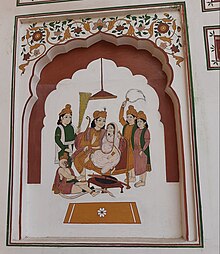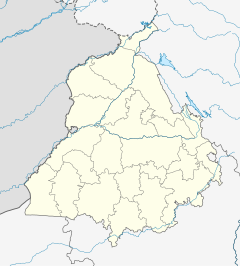| Thakurdwara Bhagwan Narainji | |
|---|---|
 Shri Ram panchayat painting at Thakurdwara Bhagwan Narainji Shri Ram panchayat painting at Thakurdwara Bhagwan Narainji | |
| Religion | |
| Affiliation | Hinduism |
| District | Gurdaspur |
| Deity | Shri Raghunath ji |
| Festivals | Rama Navami and Baisakhi |
| Location | |
| Location | Gurdaspur |
| State | Punjab |
| Country | India |
  | |
| Geographic coordinates | 32°03′26″N 75°30′08″E / 32.0571°N 75.5023°E / 32.0571; 75.5023 |
| Architecture | |
| Type | Rajputana |
Thakurdwara Bhagwan Narainji (popularly known as Pandori Dham) is a historical Hindu temple belonging to Ramanandi Sampradaya, located in the village Pandori Mahantan in Gurdaspur district of Punjab in India. It constitutes one of the fifty-two Vaishnav dvaras of Indian subcontinent into which Bairagis have been organized. The shrine was founded by Ramanandi saint Shri Bhagwanji and his disciple Shri Narainji after whom the shrine has been name.The temple is known for its spectacular Baisakhi fair.
History and tradition

The Vaishnav establishment at Pandori Dham was founded by local Ramanandi saint Shri Bhagwanji who was a Dogra Khajuria Brahmin born at Kahnuwan town in Gurdaspur. As per local tradition, Shri Bhagwanji during his early years had met Ramanandi saint Shri Krishnadas Payahari of Galta dham in Rajasthan who had brought him into order of Ramanandi Vaishnavism. The shrine is also said to have won the allegiance of Hindu princely states of hills of Jammu & Himachal. The Rajput rulers of princely states especially Nurpur, Jammu, Mankot, Guler, Basohli, Chamba, Bandralta, Jasrota, Jaswan were particularly devoted to the Pandori dham. The second Mahant of Pandori dham, Shri Narainji is said to have survived the ordeal inflicted to him by Muslim Emperor Jahangir who had poisoned him to test his miraculous powers. Shri Narainji survived which left Jahangir feel ashamed and ultimately led him to accept the supremacy of the shrine. The shrine of Pandori also received royal patronage during the reign of Maharaja Ranjit Singh who often journeyed the shrine for happiness.

Festivals and cultural events
The Baisakhi fair is at Thakurdwara of Bhagwan Narainji at Pandori Mahatan village in Gurdaspur district of Punjab where the fair lasts for three days from 1st Vaisakha to 3rd Vaisakha. The celebrations start in form of procession on morning of 1st Vaisakha, carrying Mahant in a palanquin by Brahmacharis and devotees. After that Navgraha Puja is held and charities in money, grains and cows are done. At evening, Sankirtan is held in which Mahant delivers religious discourses and concludes it by distributing prasad of Patashas (candy drops). Pilgrims also take ritual bathings at sacred tank in the shrine.
Branches and Daughter shrines
The Thakurdwara at Pandori dham extended its influence not only on neighboring Hindu hill states but also spread its branches in the form of daughter shrines, spreading all over Indian subcontinent, from Jammu in the North, Chinapattan (Chennai) in South India, Girnar (Gujarat) in the West and Ayodhya & Kashi in the east. As per the genealogy published by the Pandori dham itself, there are a total of 39 maths associated with dham which are established all over India. Apart from this, numerous minor branches are established in the towns of North Punjab, Jammu and Himachal.
Some important historical daughter shrines are that of Damtal in Kangra, Bathu in erstwhile Guler state and Lehal in Dhariwal of Gurdaspur. The list of 39 mathas spread across various Indian states and towns are as follow: 7 shrines in Hoshiarpur district (Punjab), 2 in Jalandhar district (Punjab), 1 in Amritsar district (Punjab), 2 in Kangra district (Himachal), 1 in Mandi district (Himachal), 2 in Ambala district (Haryana), 1 in Thanesar (Haryana), 1 in Saharanpur (Uttar Pradesh), 5 in Ayodhya (Uttar Pradesh), 1 in Varanasi (Uttar Pradesh), 1 in Girnar (Gujarat), 1 in Nagpur (Maharashtra), 1 each in Hyderabad, Parshottam & Chinnapattan in South India. There are 2 mathas in Jammu and 3 were there in Lahore.
Mahants
List of religious heads
Notes
- Alternatively spelt as 'Pindori Dham'.
- Alternatively spelt as 'Bhagvan'.
- Alternatively spelt as 'Narayan'.
- Not to be confused with the later mahant with the same name.
- Not to be confused with the earlier mahant with the same name.
- Alternatively spelt as 'Govind'.
References
- ^ Census of India, 1991: Gurdaspur. Controller of Publications. 1996.
Pindori known as Darbar Pindori Dham has a large establishment of Vaishnava sect which constitutes as one of 52 Vaishnava Dvars into which Bairagi establishments are organised.
- Journal of the Royal Asiatic Society of Great Britain & Ireland. Cambridge University Press for the Royal Asiatic Society. 1971. p. 157.
The Dhyanpur gaddi is known as "Lāldvārā" much as the Pindori gaddi, also in the Gurdaspur district, is known as the dvārā of Bhagwan-Narain ji.
- Chaitanya, Krishna (1976). A History of Indian Painting. Abhinav Publications. ISBN 978-81-7017-310-6.
The seat of the hieratic head or Mahant of the Ramanandi sect was Pindori, seven miles east of Gurdaspur.
- ^ Darshan. Consulate-General of India. 1982.
The most spectacular Baisakhi gathering can be seen at Pandori mahantan in the village of Tallpur (Gurdaspur district)
- Ghurye, Govind Sadashiv (1964). Indian Sadhus. Popular Prakashan. ISBN 978-81-7154-605-3.
The centre at Pindori in Gurdaspur district of Punjab, for example, is recorded to have been founded by one Bhagawan who was born in A.D. 1449.
- Charak, Sukh Dev Singh; Billawaria, Anita K. (1998). Pahāṛi Styles of Indian Murals. Abhinav Publications. ISBN 978-81-7017-356-4.
Among the converts of Bhagwanji was a devotee, named Narainji who was afterwards known as Bhagwan-Nārāinji and whose miracles find illustration in the murals of the shrine
- Burchett, Patton E. (28 May 2019). A Genealogy of Devotion: Bhakti, Tantra, Yoga, and Sufism in North India. Columbia University Press. ISBN 978-0-231-54883-0.
According to the tradition of Pindori Dhām, a major Rāmānandī center in the Gurdaspur district of Panjab, the young Bhagvān-jī met Kṛṣṇadās Payahārī at Galta while on a pilgrimage. Payahārī is said to have converted him to Vaiṣṇavism
- Roopa-Lekhā. All-India Fine Arts and Crafts Society. 1971.
The Mahants of Pindori stood in a similar relationship with the Rajput chiefs of the hill States. There is evidence at Pindori that the rulers of Nurpur, Chamba, Guler, Jaswan, Jammu, Bandralta and Mankot, among others, offered...
- Bengal, Past & Present: Journal of the Calcutta Historical Society. The Society. 1971.
...dates back to the days of Emperor Jahangir. Narainji, the second Mahant, according to traditional accounts, survived an ordeal by poison in the presence of Jahangir who bequeathed to
- Sharamā, Rādhā (2007). Contemporary and Later Perspectives on Maharaja Ranjit Singh. Guru Nanak Dev University. p. 9. ISBN 978-81-7770-141-8.
According to Indu Banga, the Bairagi establishment of Pindori near Batala was 'more affluent in the Sikh times than ever before or perhaps even after'
- Suri (lala), Sohan Lal (1961). pts.1-5.Chronicle of the reign of Maharaja Ranjit Singh, 1831-1839 A.D. S. Chand. p. 34.
Secondly, it stated as to how he journeyed from Kapurthala to Talibpur Pindori and became a source of happiness for the Mahararja
- Punjab (India) (1992). Punjab District Gazetteers: Supplement. Controller of Print. and Stationery.
- Anand, R.L. (1962). Fairs and Festivals, Part VII-B, Vol-XIII, Punjab, Census of India 1961. p. 60.
- Proceedings - Punjab History Conference. Department of Punjab Historical Studies, Punjabi University. 1988.
but also spread its branches from Jammu in the north to Chinapattan in the South, Girnar in the west and Ajodhya in the east
- ^ Sinha, Surajit; Saraswati, Baidyanath (1978). Ascetics of Kashi: An Anthropological Exploration. N.K. Bose Memorial Foundation.
From a genealogy published by Pindoridham in 2018 VS, it appears that there are at least 39 important gaddis (or mathas), belonging to Bhagwanji Dwara, spread all over in different parts of the country
- Goswamy, B. N.; Fischer, Eberhard (1997). Pahari Masters: Court Painters of Northern India. Oxford University Press. ISBN 978-0-19-564014-4.
The early years of the seventeenth century saw a concerted effort towards taking the message of Vaishnavism into the hills through the founding of monasteries like Pindori and its offshoots at Damtal and Bathu
- ^ Goswamy, B. N.; Grewal, J. S. (July 1969). "Introduction". The Mughal and Sikh Rulers and the Vaishnavas of Pindori: A Historical Interpretation of 52 Persian Documents. Calcutta: Indian Institute of Advanced Study. p. 12.
- ^ "Home". Pindori Dham. 2006. Archived from the original on 10 February 2010. Retrieved 11 November 2024.


